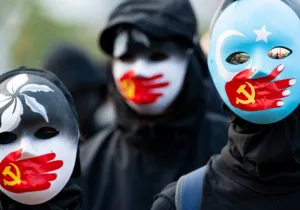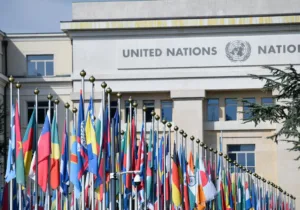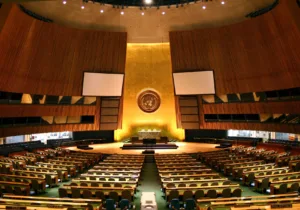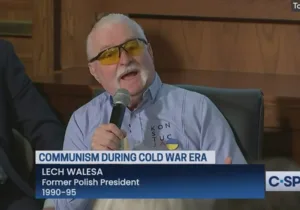With the return of armed conflict in continental Europe, the Russian Federation is committing brutalities that have characterized the most violent of warfare since ancient times.
Cold-blooded executions, brutal mass rapes, the bombings of a maternity ward and shelter for children, along with the forced displacement of roughly 500,000 Ukrainians into Russia, are just some of the atrocities the Russian Federation has committed in its unjust war against Ukraine.
At first, some of these incidents were thought to be isolated events. But a high-profile Organization for Security and Cooperation (OSCE) investigation in April – which Russia refused to support – found that Russian war crimes have been quite extensive, both in nature and scale. Mass graves in Bucha, containing the bodies of hundreds of Ukrainians, are one of the reasons why world leaders are now using the word ‘genocide’ to describe Russian misconduct in Ukraine.
Russia has actively sought to cover up its soldiers’ crimes by engaging in disinformation campaigns. Predictably, Russian Twitter criticized the April OSCE report as “unfounded propaganda.”
Making matters even worse, reports are now filtering through on the increased risks of human trafficking for the millions of women and children fleeing into bordering Poland. Desperate for transportation and assistance, it is all too tempting for refugees to accept rides from traffickers promising shelter and assistance.
The Polish government’s compliance with widely-accepted, international anti-trafficking standards has been less than stellar. Not only has Poland struggled to get its law enforcement efforts up to par and lacked a centralized system to track data on investigations, but in 2018 the Polish Ministry of the Interior liquidated the government’s interagency body in favor of a new organization directly under the Ministry’s control and less oversight. This kind of move is common in countries swinging toward authoritarianism.
Polish leaders have had plenty of time to make needed improvements, and over the past two decades, the US State Department’s Trafficking Office, European organizations and institutions, and numerous NGOs have repeatedly offered the government clear directions for progress. Poland finally passed legislation to increase the penalties for traffickers. But it will be interesting to see if the increasingly rigid Polish government continues to fail to respond to efforts from human rights organizations to help it identify ways to improve on anti-trafficking.
One common misconception about human trafficking is that the fight can be won through the efforts of non-profit and advocacy organizations. When the La Strada Foundation (a Polish-based network of anti-trafficking non-profits) emerged in 2005, scholars and activists were hopeful. But in a few short years, it became obvious that the scale of the trafficking problem in Poland was something that even the best civil society attempts were unequipped to tackle…and this was before the arrival of millions of Ukrainian refugees.
More often than not, human trafficking is a political will problem. It usually takes a powerful actor wielding some kind of material incentive or penalty to get political elites to take action. Given these realities, it is worth pointing out how both the North Atlantic Treaty Organization (NATO) and the European Union (EU) have zero-tolerance policies on human trafficking.
Moving forward, NATO should consider the role it could play in encouraging members toward meeting international anti-trafficking standards. It is possible to write NATO policies in such a way that would tie government compliance with international anti-trafficking standards so as to veto privileges or financial contributions. Meanwhile, the European Union, having built a web of institutional bodies to address human trafficking, can be more assertive in devising and instituting consequences for member states that fail to meet international standards.
But the new hot zones for trafficking in Poland are not just the result of the government’s stubborn refusal to prioritize anti-trafficking. They are the product of Russian violations of international use of force protocols in Ukraine.
These ripple effects should remind Americans of why the US engages abroad. Particularly in anti-trafficking, the US’s leadership has often gone unnoticed.
Not only is the US the backbone of NATO – the most powerful alliance on earth and a deterrent on further Russian advancements into Europe – but for the past two decades the State Department has been acting like a global sheriff when it comes to enforcing international anti-human trafficking standards.
NATO’s zero-tolerance policy on trafficking was largely the result of US pressure and influence. The policy grew out of a report that US Congress demanded on NATO peacekeeper involvement in human trafficking in Bosnia and Kosovo. The report concluded that human trafficking was undermining NATO missions.
US and Norwegian ambassadors then pressured NATO to adopt its zero-tolerance policy in the early 2000’s. American influence was critical in this context. Years later, the Norwegian ambassador acknowledged how, without backing by NATOs critical member state, other NATO members “would just have not bothered” to take anti-trafficking seriously. NATO’s current anti-trafficking curriculum is also based on trainings that U.S. Forces Korea developed to combat trafficking around military bases.
Even Russia’s own laws on anti-trafficking – though rarely enforced – are a product of American pressure and influence abroad. In the early 2000’s, the Duma finally adopted national legislation after American diplomats directly threatened Russia with sanctions.
Not only does the US provide the military capabilities needed to preserve the potency of the world’s strongest military alliance, it has also led the charge when it comes to building the moral authority NATO needs for continued effectiveness against tyrants who show no regard for human dignity.






